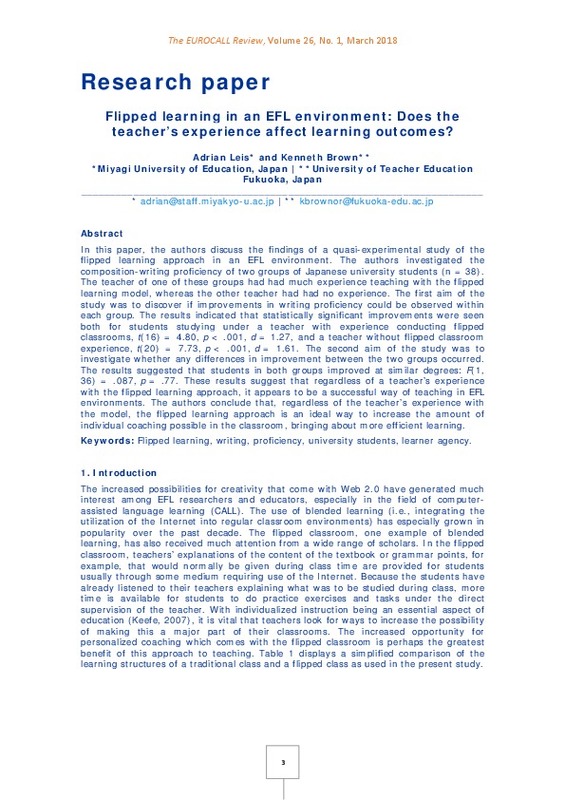Anderson, J. (1986). Taking charge: Responsibility for one's own learning. Unpublished MA Thesis. The School for International Training, Brattleboro, VT.
Baker, J. W. (2000). The "classroom flip": Using web course management tools to become the guide by the side. In Selected Papers from the 11th International Conference on College Teaching and Learning, 9-17.
Benson, P. (2011). Teaching and researching autonomy. Harlow, England: Pearson Education.
[+]
Anderson, J. (1986). Taking charge: Responsibility for one's own learning. Unpublished MA Thesis. The School for International Training, Brattleboro, VT.
Baker, J. W. (2000). The "classroom flip": Using web course management tools to become the guide by the side. In Selected Papers from the 11th International Conference on College Teaching and Learning, 9-17.
Benson, P. (2011). Teaching and researching autonomy. Harlow, England: Pearson Education.
Bergmann, J., & Sams, A. (2012). Flip your classroom: Reach every student in every class every day. Eugene, OR: International Society for Technology in Education.
Brinks Lockwood, R. (2014). Flip it!: Strategies for the ESL classroom. Detroit, MI: University of Michigan Press.
Crouch, C. H., & Mazur, E. (2001). Peer instruction: Ten years of experience and results. American Journal of Physics, 69(9), 970-977. doi: 10.1119/1.1374249
Dam, L., & Legenhausen, L. (1996). The acquisition of vocabulary in an autonomous learning environment-the first months of learning English. In R. Pemberton, E.S. Li Li, W.F. Or, & H.D. Pierson (eds). Taking control: Autonomy in language learning. Hong Kong: Hong Kong University Press, 265-280.
Forsythe, E. (2016). Pedagogical rationale for flipped learning and digital technology in second language acquisition. In Information Res Management Association (ed.), Flipped instruction: Breakthroughs in research and practice. Information Science Reference, 116-130. doi: 10.4018/978-1-5225-1803-7.ch007
Fraser, C. A. (2007). Reading rate in L1 Mandarin Chinese and L2 English across five reading tasks. The Modern Language Journal, 91(3), 372-394. doi: 10.1111/j.1540-4781.2007.00587.x
Harumi, S. (2011). Classroom silence: Voices from Japanese EFL learners. ETL Journal , 65, 260-269. doi: 10.1093/elt/ccq046
Holec, H. (1981). Autonomy in foreign language learning. Strasbourg, France: Council of Europe.
Hung, H. T. (2015). Flipping the classroom for English language learners to foster active learning. Computer Assisted Language Learning, 28, 81-96. doi: 10.1080/09588221.2014.967701
Keefe, J. W. (2007). What is personalization? Phi Delta Kappan, 89(3), 217-223. Retrieved from http://journals.sagepub.com/doi/pdf/10.1177/003172170708900312
Lage, M. J., Platt, G. J., & Treglia, M. (2000). Inverting the classroom: A gateway to creating an inclusive learning environment. The Journal of Economic Education, 31(1), 30-43. doi:10.2307/1183338
Larson-Hall, J. (2008). Weighing the benefits of studying a foreign language at a younger starting age in a minimal input situation. Second Language Research, 24(1), 35-63. doi:10.1177/0267658307082981
Lee, G., & Wallace, A. (2017). Flipped learning in the English as a foreign language classroom: Outcomes and perceptions. TESOL Q , 1-23. doi: 10.1002/tesq.372
Lee, P. J. (2017, June). Effects of interactive subtitles on EFL learners' content comprehension and vocabulary learning. Paper presented at JALTCALL2017 Conference, Matsuyama, Japan.
Leis, A. (2015). Dynamics of effort in flipped classrooms in an EFL environment. Educational Informatics Research, 14. 15-26. Retrieved fromhttps://www.researchgate.net/publication/289530659_Dynamics_of_Effort_in_Flipped_Classrooms_in_an_EFL_Environment
Leis, A. (2016). Flipped learning and EFL proficiency: An empirical study. Journal of the Tohoku English Language Education Society, 36. 77-90. Retrieved fromhttps://www.researchgate.net/publication/303759005_Flipped_Learning_and_EFL_Proficiency_An_Empirical_Study
Leis, A., Cooke, S., & Tohei, A. (2015). The effects of flipped classrooms on English composition writing in an EFL environment. International Journal of Computer-Assisted Language Learning and Teaching, 5(4), 37-51. doi: 10.4018/978-1-5225-0783-3.ch062
Lim, K. M., & Hui Zhong, S. (2006). Integration of computers into an EFL reading classroom. ReCALL, 18(2), 212-229. doi: 10.1017/s0958344006000528
Little, D. (1990). Autonomy in language learning. In I. Gathercole (ed.) Autonomy in language learning, London, England: CILT, 7-15.
Loewen, S., & Plonsky, L. (2016). An A - Z of applied linguistics research methods. New York, NY: Palgrave Macmillan.
Lyster, R. (2004). Differential effects of prompts and recasts in form-focused instruction. Studies in Second Language Acquisition, 26(4), 399-432. doi: 10.1017/s0272263104263021
Matsukawa, R., & Tachibana, Y. (1996) Junior high school students' motivation towards English learning: A cross-national comparison between Japan and China. ARELE: Annual Review of English Language Education in Japan, 7, 49-58. Retrieved from https://www.jstage.jst.go.jp/article/arele/7/0/7_KJ00007108213/_pdf
Mazur, E. (1997). Peer instruction: Getting students to think in class. AIP Conference Proceedings, 981-988. doi: 10.1063/1.53199
Mehring, J. G. (2015). An exploratory study of the lived experiences of Japanese undergraduate EFL students in the flipped classroom. (Doctoral dissertation, Pepperdine University). Retrieved from https://www.academia.edu/12538458/An_Exploratory_Study_of_the_Lived_Experiences_of_Japanese_Undergraduate_EFL_Students_in_the_Flipped_Classroom
Perez, M. M., Norgate, W. V. D., & Desmet, P. (2013) Captioned video for L2 listening and vocabulary learning: A meta-analysis. System, 41(3), 720-739. doi:10.1016/j.system.2013.07.013
Sasaki, M. (2011). Effects of various lengths of study-abroad experience on Japanese EFL students' L2 writing ability and motivation: A longitudinal study. TESOL Quarterly, 45(1), 81-105. doi: 10.5054/tq.2011.240861
Yang, J. C., & Chang, P. (2014) Captions and reduced forms instruction: The impact on EFL students' listening comprehension. ReCALL, 26(1), 44-61. doi: 10.1017/s0958344013000219
[-]







![HTML file [HTML]](/themes/UPV/images/html.png)

